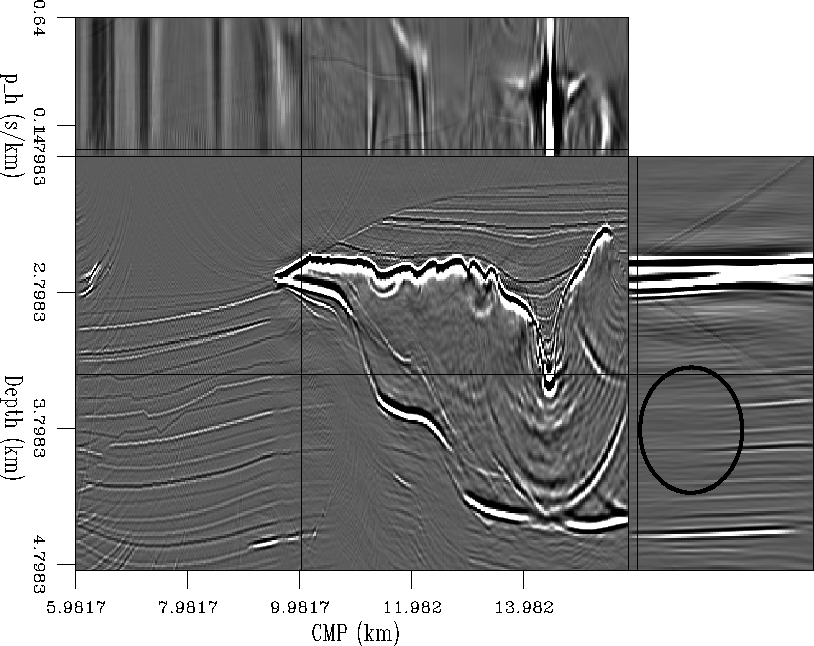 |
Figure 1 Result of angle-domain wave-equation migration.
We applied our preconditioned inversion scheme to a synthetic dataset provided to us by SMAART JV. This dataset is designed to have a significant shadow zone underneath the salt body. The result of angle-domain wave-equation migration of this dataset can be seen in Figure 1. In the CMP-depth plane, note the severe decrease in amplitude of the reflectors as they go beneath the salt. In the offset ray parameter (ph)-depth plane, there is a large decrease in amplitude at small ph. It is most visible inside the oval drawn on the figure. We consider this to be a ``hole'' in the event, since there is energy at very small ph and large ph.
 |
Figure 2 shows the result of 3 iterations of 1-D preconditioned inversion. Recall that the 1-D preconditioning scheme acts horizontally along the ph axis. The most obvious result of this is a substantial increase in the signal to noise ratio. In the context of this paper, the more interesting result is the increase in strength of the events along the ph axis. The ``hole'' that is circled in the ph-depth plane is beginning to fill in. This in turn makes the reflectors in the CMP-depth plane appear to extend farther under the salt, with stronger amplitudes. This result is encouraging, but it seems likely that several more iterations would be necessary to really fill the hole.
 |
To help fill in the shadow zones faster, we used our 2-D preconditioning scheme. To do this, we first picked reflectors in the CMP-depth plane (Fig. 3) to be used to create the preconditioning operator in this dimension. In the inversion, this operator was cascaded with the operator that smooths horizontally along the ph axis.
 |
The result of 3 iterations of the 2-D preconditioning scheme can be seen in Figure 4. This result is smooth and very promising. The hole in the ph axis is gone and the reflectors extended underneath the salt with a stronger amplitude. Unfortunately, this method also creates some obvious errors in the output image. The top of the salt has lost some of its features because the picked reflector there was not detailed enough. Also, the faults at the left side of the image have been smoothed out. In this case, neither of these areas are of particular interest, but the problem of smoothing areas that shouldn't be smoothed is one we are trying to solve.
 |
One way to reduce the smoothing effect is to follow several iterations of the preconditioned inversion (Equation 3), which tends to be smoother with fewer iterations, with a regularized inversion (Equation 2), which tends to be rougher with fewer iterations. The result of 3 iterations of preconditioned inversion followed by one iteration of regularized inversion can be seen in Figure 5. The result looks similar to the migration result (Fig. 1). Many events containing higher frequencies have been revived, including some of the processing artifacts. However, close examination of the areas of particular interest reveals important improvements.
In the CMP-depth plane, the reflectors going beneath the salt do not have the hole directly beneath the tip of the salt that is seen in the migration result. In the circled area in the ph-depth plane, the reflectors are more constant in amplitude than in the migrated result. These improvements could be increased with more iterations of regularized inversion. We are working on a way to determine a better combination of preconditioned and regularized iterations.
 |